The Roofnest Sparrow is growing up…Literally. And figuratively. The 2nd 3rd generation Roofnest Sparrow, coming out in 2020 is bigger than the previous model, and better in many aspects. What’s changed, and how does the Roofnest Sparrow keeps up with the competition?
Roofnest Sparrow 2020 Review
The thing is, that the previous Roofnest Sparrow was a great roof tent too. It was the most popular model not just in the US but in the UK too. And while it was not without faults – or rather, minor inconveniencies – considering the price tag the Roofnest Sparrow was a great buy.
The good news is, that the sour seeds of customer ‘complaints’ fell on fertile ground: Roofnest has listened to their faithful followers and upgraded the Roofnest Sparrow for 2020. Why would not they? It’s a quick win: minor fixes that don’t cost a dime (in the grand scheme of things), but can make a lot of difference not just in PR, but in actual everyday usage of the Sparrow.
Who is the Roofnest Sparrow for?
The Roofnest Sparrow is a 2-person roof tent, ideal for couples and solo campers.
Size
The internal width is 125 cms / 49″ which is just about enough for two people to sleep comfortably, and there is still some space left for a dog and/or some gear
The internal length is almost 210 cms / 6’10”, so even if you have grown high, you will find the Sparrow spacious.
One of the 2020 upgrades in the increased headroom: the new Roofnest Sparrow is now 4″ higher than the previous model, increasing the internal height to 40″ / 101 cms. This is still not plenty, but it’s much better than it was: at least you can sit up comfortably if you need to kill time inside waiting for the rain to stop.
When the fibre-reinforced hardshell lid is closed, there is only a 28 cm / 11″ high profile. Thanks to the streamlined profile, wind drag and wind noise are kept to minimal.
Weight / Fitting / Pitching
The Roofnest Sparrow weighs 110lbs / 58kgs, which is very good for a hard-shell roof top tent. You can easily fit the Roofnest Sparrow onto smaller estates with 165lbs dynamic load capacity (typical value for most smaller cars). Low weight is also beneficial when handling your car, having less effect on the stability.
It’s also easier to lift the Sparrow on top of your car, however it is still a two-person lift.
The good news is that once it’s on, you only need to secure 4 universal brackets / 8 bolts. The whole process should not take longer than an hour.
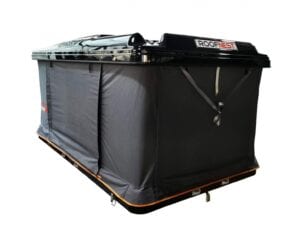
You can close the rainflies fully, to block out light completely. Straps help pulling the lid down.
The Roofnest Sparrow is compatible with most, normal size crossbars, however it’s recommended to use Thule Aeroblades or something similar, low profile crossbars. The only difficulty you can come across is the lack of space between the floor panel and the roof of your car, especially if your crossbars sit low.
Pitching is a piece of cake thanks to the gas assisted struts. You just need to unlatch the metal buckles, and the lid pops up in under 60 seconds.
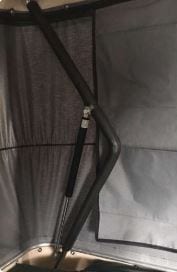
Gas assisted struts help opening the Roofnest Sparrow.
Closing it is almost as easy as opening. Once you caught the pullie-straps and managed to pull one side down, you lock it. Then repeat it on the other side.
It needs a bit of practicing: when you are pulling down the end, the front might pop open…
Sleeping in the Roofnest Sparrow
There is 4 way access to the Roofnest Sparrow with hooks for the telescopic alu-ladder underneath each door. Thanks to this, when one is used as a door, other three are just large windows, letting in plenty of light and air if needed.
The mattress is not just large, but it’s much thicker than the average.
It’s 3″ thick and there’s an extra anti-condensation mat underneath the sponge. Some users find it very comfy, others think it’s a bit too plushy – it’s always subjective. What’s need remembering though, that if you are heavier (ie. over 200lbs) then you might feel the aluminium floor pushing through the sponge, against your hip.
The mattress cover can come off for washing purposes which is a nice feature as well.
If only the gas struts did not protrude into the sleeping area…fortunately they don’t take up as much shoulder-space, but they are not very nice to look at. A sleeve on the struts could go a long way…
The inside of the shell is coated with an insulation layer and quilted fabric to insulate, reduce noise, and give the inside a soft “feel”.

Large windows and doors: the Roofnest Sparrow feels soft and airy. The gas struts take up a bit of space unfortunately
All windows / doors have a mesh panel and a rainfly, zipped separately. The rainflies can be zipped in at night if you prefer to sleep in pitch dark: they block out light completely. If you don’t need them, you just roll them up, and you can enjoy the view through the glorious large windows; or you can use them as a canopy.
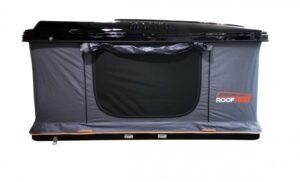
Mesh panel on all windows and doors on the Roofnest Sparrow. The rainfly can be rolled up.
The only inconvenience is the ladder: the steps are a bit narrow and their surface is not parallel with the ground. Climbing up and down can be a painful exercise – especially barefoot.
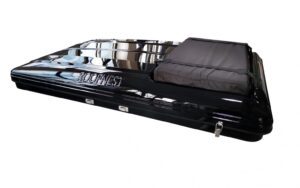
Storage area on top of the Sparrow.
Storage
As for storage space, the new Sparrow has significant improvement over the older model. There are new detachable pockets which can be secured to the outside of the tent for shoe storage.
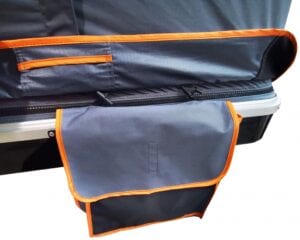
External storage pockets…
On the new model there is an external storage area on top of the shell, with an included waterproof storage bag that can be attached to the lid.
Fabrics / Tent Wall
The wall is made of 280 gsm PU coated polyester and cotton blend fabric, also known as poly-cotton. It has a waterproof rating of 3000mm HH, which is a typical value of many roof top tents. On top of the natural water-repellent properties of the polycotton, this PU coating ensure that no water get through the weaves.

Polycotton tent wall. heavy duty zippers.
The PU / polyurethane coating on the other hand, reduces the natural breathing of the poly-cotton; which increases the chance of condensation on cooler mornings…Condensation should not be a big issue, not in a polycotton tent, but you can’t eliminate it fully.
Apart from this, water should not get inside, and thanks to the inner insulation layer on the shell, the 280gsm tent walls, the Roofnest Sparrow is much quieter than any other polyester tent.
The polycotton also has very good thermal properties: on top of being a good insulator for noise, it is good at keeping the warmth in too.
If you’d like to know more about HH ratings and different tent fabrics (pros and cons), and other acronyms used in the industry, click here:
Tent materials, fabrics, specifications and all the acronyms. FAQ.
Extras & Accessories
There is an area on the shell designed specifically for attachment of a flexible solar panel, like this.
But there are no mounting points, nor a cable entry point other than the windows / door, so as great as it sounds, as basic it is. Nevertheless, you can fit a solar panel of up to 160W power on top of the Sparrow.
Awning: you can attach the Roofnest Little Wing awning to the side, however, it’s a bit flimsy. Although the Roofnest Sparrow is tested to withstand strong winds, the awning is not, so in windy weather you’d better keep it in the back the car.
Negatives
The Roofnest Sparrow is a great little roof tent, but there are a few things that are worth considering before buying.
- Wind Noise – despite having a low, streamlined profile, there will be some wind noise especially at higher speed. It can sometimes be frustrating, but if you close the windows you won’t hear it as much.
- Door Access – this is typical of every hard-shell roof tent. These roof tents don’t fold out like soft-shell roof tents, meaning that they are as wide as your car. The Roofnest Sparrow is not an exception: when it’s fully set up and you attach the ladder, the doors on that side will be blocked. If you set up the ladder at the back of your car, you probably won’t be able to open the back of your car.
This is something that all hard-shell roof tents share…:( - The ladder itself could be better / better thought out. You may be better off buying an aftermarket telescopic ladder that has level steps, or at least some rubber on the top
Where to buy the Roofnest Sparrow
The easiest way to get hold of a Roofnest Sparrow is via the official website:
Roofnest US ($2895)
Roofnest UK (as of March 2020. The 2020 Sparrow is not yet available. The older model costs £1595)
Alternatives
The obvious alternatives are the other Roofnest Models, the Sparrow Eye, the Eagle, or the Sandpiper.

Roofnest Eagle
The less obvious alternatives are, and it’s far from being a comprehensive list;
TentBox* ($2999 through the new website, or $2495 from Amazon via Tent-Box US* / £1995 in the UK). Shipping is included in the price.

Tent-Box – although slightly heavier, a great alternative to the Roofnest Sparrow
Tepui HyBox from Thule for $3000, from REI for $2899 or from Amazon US*. In Europe, you can get hold of a Tepui HyBox from Amazon UK* or from Daktent.NL for around £2500. For detailed info on the Tepui Hybox click here Tepui HyBox v Roofnest Eagle 2019 Comparison.
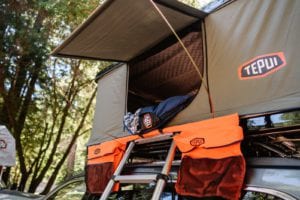
Tepui HyBox – Slightly bigger than the Sparrow.
Maybe, the Autohome Maggiolina AirLand Plus Small ($3099), Small XL ($3398) or Medium ($3299). In the UK, the Maggiolina BOAB Black for £2825.
Lastly, the BigFoot Tents Explorer for $2795 from Rooftoptentsofficial.
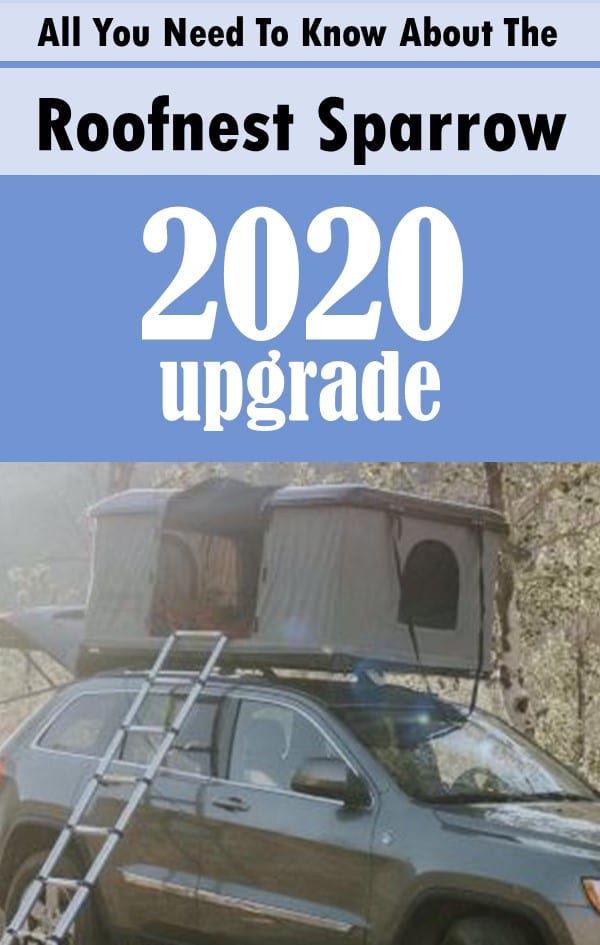
Share It!
*Affiliate Links. While you pay the same price for the item, I may earn a small commission if you click on those links and make a purchase later. Full Affiliate Disclosure here.

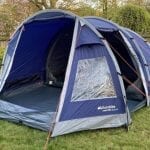

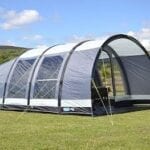
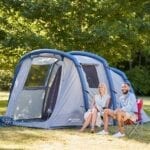
you guys list the 2020 sparrow weight at 110 lbs. roofnest has it listed at 130 lbs.
You’ve got to be kidding me:). The sparrow is almost impossible to take down without two men. Roofnest says to not take it down one corner at a time, and the straps in front aren’t long enough for one person to pull forward. I was hoping for independence.
I did see one system in a blog using a pulley system which is doable, but from all of the videos I watched and Roofnest people I talked to, I did not imagine that taking it down was anything other than easy!!
Hi there,
you are absolutely right. But honestly, I’ve no idea which part of this post you replied to.